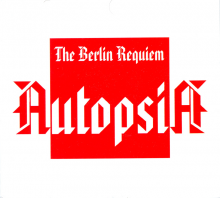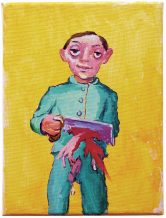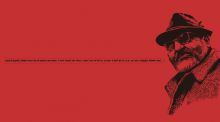| Umělec 2002/4 >> Big Hope (Interview with Miklos Erhardt and Dominic Hislop) | Просмотр всех номеров | ||||||||||||
|
|||||||||||||
Big Hope (Interview with Miklos Erhardt and Dominic Hislop)Umělec 2002/401.04.2002 Keiko Sei | q & a | en cs |
|||||||||||||
|
Could you please speak a little about the meaning of your project in Torino, why you wanted to do it, to what ends, and why in an art gallery?
M.E., D.H.: We first went to Corso Brescia 14, Torino, around six months ago while we were working on a previous project. We were immediately impressed by this colorful space, its rich variety of objects, paintings, posters and stencils that covered its walls. They host the activities of a group of people composed of adult women and men who have jobs doing various kinds of social work. They also work long hours for no pay to give assistance to, and organize protests on behalf of, migrants. As our projects use art channels to achieve the same goals and we also tend to invest a lot of time in activities that are not financially rewarding, there was an immediate mutual sympathy for each other’s work. It was then that the idea of documenting their activities and recreating the environment of their meeting space in a different location first came up. More generally speaking, with the “global justice” movement’s growing popularity and recent high profile protests in Seattle, Prague and Genova etc. we can clearly see how ‘the system’ has seized the opportunity to recuperate and commodify their practical and low-tech imagery. Since the exposure of Nike’s unregulated sweatshops in developing countries they have been one of the movement’s prime targets of protests and boycotts. In an attempt to confuse its function, Nike’s recent “scorpion team” advertising campaign featured the kind of cutout stencil spray painting imagery that is traditionally associated with the aesthetics of resistance in its posters. They even sprayed directly onto walls and buildings. They calculate the appeal of the aesthetics of resistance, but neutralize any political content and intention to agitate. The Disobbedienti project was an attempt to reproduce imagery of a very specific part of the global justice movement and present it together with the original content and context, in a way that avoids confusion with any other signification or message than that of the representation or re-creation. In doing so, it seeks to restate a connection between imagery and content, which can generate awareness of and counter its recuperation and commodification. For this, an art gallery, with its neutral space and relatively neutral context, can be an appropriate location. This location also provided the opportunity to react to the politically and socially sterile atmosphere of the majority of the Hungarian art scene. This atmosphere is characterized by a “sophisticated understanding” of contemporary political, economic and social realities, without drawing any practical conclusions from this understanding. To this well-ordered and not very lively garden, we wanted to contribute an unclear, unclean and disordered but living and active environment. Were there any reservations on the part of the gallery or anyone else involved in this project? M.E., D.H.: The Liget gallery is run by a friend of ours, Tibor Varnagy, an artist who shares our interest in “reality-based” art. So from that perspective, no obstacles were imposed. From the side of the Torino Disobbedienti, they only asked us not to record while they discussed some “surprise” tactics that they wanted to use at a demonstration in November. As they were keen to get some feedback and they were curious to learn more about activist circles in Hungary, we decided to record an interview with relevant activists in the gallery space in Budapest. When sent to Torino, this could relate their answers to the same questions answered by Disobbedienti and create some communication that could bring together an international support network of like-minded organizations. This “condition” agreed with our intentions anyway, which consist of making art projects that somehow interact with some kind of social reality, and try to facilitate communication both between different social groups that somehow lack the adequate channels, between the contemporary art scene and other marginalized social spheres. Do you consider the contemporary art scene to be marginalized? M. E.: Yes, I think there is something marginalized in contemporary art, but I’m not sure if it’s a bad thing or good. It has lost its leading position in innovation, high-tech visuality, even in subversion, the latter being the final fortress since the Situationists. The system’s personal “avantgarde,” i.e. the advertising industry, produces the most exciting imagery today, both quantitatively and qualitatively, and you cannot beat it with art. By contrast, the visual arts in their most autonomous appearance are like a laboratory where essences are produced, pure and hermetic. Art became weak, and it doesn’t know yet how to use its weakness as a strength, although I think this situation favors some less visually aggressive, more “morality” based work. Please tell us briefly about your previous and future projects, if you have any specific plans that bring together the art scene and marginalized social spheres. M.E., D.H.: We made our first common project from 1997 to 1998. The work took eight months. We gave disposable cameras to homeless people in Budapest and asked them to document what they thought would be worth showing in an exhibition from their everyday experience. The photos were shown in an art gallery, and the largest homeless shelter in Budapest. They can also be seen on a web site (www.c3.hu/collection/homeless) with a comment by the person who took it alongside. Then we did some public- and gallery-based works together before beginning another large-scale project of this kind. There was a project called Re:route which we did for the BIG Torino Biennial of Art, 2002. It consisted of a mapping of the city of Torino by about 30 recent migrants. Even on a European scale, Torino has experienced a massive immigration of legal migrants, refugees and illegal workers, from various developing and Eastern European countries, which has made the social balance of the town delicate. The participants were asked to sketch a ‘mental map’ of the parts of the town they used everyday or were impressed by, both positively or negatively, then to illustrate the map with photographs. We recorded two interviews with them, first about the map and then about the individual photos. The first stage of presentation was a web site (reroute.c3.hu ) and installation. The next phase will be in spring 2003 when we make the results more “public” by printing a version of the map which will be distributed for free to both incoming immigrants, through various social organizations, and the general public. The map will take the same format as those currently available as tourist maps, but will be composed of the material of the project, providing both “poetic” information from the comments and photos, and “useful” information, a selection of the most important immigrant support groups, NGOs, and ethnic organizations. What was the response of the participants of those projects? M.E., D.H.: In both projects everyone we approached was interested in participating, and for the right reasons, I think, as we didn’t mention anything about financial reimbursement until after they had agreed to take part. The essential element of participation — taking a photograph and talking about it — is universally appreciated, but it is often taken for granted. At the stage of presentation, I think those that made it to see the exhibition opening, which was attended by an enthusiastic public, were proud to have contributed to something so appreciated. I think an important aspect of the process was that an outsider to their situation became involved with them, spent time listening to their experience and views and that through this dialogue they created something that, on the one hand, enabled a reflection on their own personal situation and, on the other, could communicate something of interest to a broad public. People [from Eastern Europe] seem to buy [Spanish and Italian leftist stereotypes], or rather they may actually want to since this is a former communist country. People still hold resentment towards the “radical or extreme” left. I think your project at the Liget Gallery is helping people to be properly informed about what these groups are really doing. I know you have also been translating and publishing leftist texts in Hungary. Still, the Italian leftist scene is so rich and colorful, and since Autonomia there have been so many groups, positions, opinions and activities that one needs much devotion to understand the true picture of what’s going on. Do you see the need to connect Italian (or other) leftist ideas and their agendas to those of former Eastern Europe as much as you try to connect the art scene and other social scenes? How effective is it? Can art be a good mediator for this purpose? M.E.: As far as the Hungarian situation is concerned, I can state that much of what the question mentions is valid here, too. The difference being that in Budapest people don’t have the experience of massive alternative globalization protest. So the danger doesn’t seem to be so imminent, and all these stereotypes haven’t been formed about Italian and Spanish leftist groups. The slogan of the day is “terrorism and anarchism” as these expressions are likely to generate dissent and distrust among citizens. Generally speaking, the atmosphere is characterized by the “it’s not our business” attitude. This is good old Central European mentality.1 In Eastern Europe the issue of leftism is particularly delicate due to the state capitalist (called communist) past of the region. Most of the ideas and slogans launched by the street movement here are considered long obsolete. In this regard it is important, and hopefully inspiring, to represent everything that can be a vehicle of a different, organic reality. Or, if you like, a particular local reality different from our own local reality, in a context in which mainstream, and in its most aggressive tactics, the independent media and politicians are pressing for a cultural-economical globalism, i.e. uniformity. About it being effective, I don’t think we should have very high expectations about the large-scale impact of an exhibition. There are of course more efficient methods and locations in which to spread a different consciousness than in the art gallery (from public protest to media appearances). The premises and situation of gallery art make it too isolated and safe a place, where different strategies of protest are likely to end up being satisfying but irrelevant. This was one of the reasons why we chose “modest” means of reproduction, instead of using the false supremacy of art to make a political statement. D. H.: As they know the landscape better than me, I mentioned the perception of Italian and Spanish groups in Prague to some of the Disobbedienti group who were in Prague at that time, and they were a little surprised as they were with a peaceful “yellow” group. They said they always had the impression that it was the German and Austrian “Black Bloc” that usually initiated the more extreme behavior. They thought that although the Autonomia groups were more extreme than the Disobbedienti, there wasn’t really an Italian equivalent of the “Black Bloc,” and that those Italians who did favor more radical tactics would be likely to share the views and strategies of a larger and more international Black Bloc than operate independently as a national group. Generally, there seems to be a desire on the part of the establishment to blur the distinction between violent and non-violent strategies. This could be seen quite clearly in the attempts by Italian politicians and media to criminalize the current “global justice” movement in the lead up to the recent European Social Forum in Florence. In any political cause, extreme tactics are an almost inevitable consequence of people becoming frustrated when legitimate grievances consistently fall on deaf ears. The “Black Bloc” minority amongst the protesters at the G8, WTO, IMF or NATO meetings are the extreme end of the “global justice movement” in the same way that al-Qaeda are the extreme end of those Arabs angry about US policy in the Middle East, and they have both provided the establishment with the justification to dismiss critique of heavy-handed repressive measures. To go back to some reasons for the exhibition in Hungary, when I lived in Hungary I perceived an ingrained cynicism and impotence among my Hungarian peers towards political discussion and involvement. With the perception among many Hungarians that the left had been discredited by its abuse of power, a large part of the political territory for raising consciousness of a government that, like those of Western Europe, puts corporate power before public interest has been claimed by the nationalist right. Consequently, it’s more common to see sizeable demonstrations from the nationalist right in Budapest than the left, moreover, unlike other parts of Europe, they are allowed to parade the main streets and squares uncontested. By marked contrast, Italy has a sizeable, colorful and vibrant culture of taking to the streets. In presenting the environment and activity of an Italian activist group in Hungary, one aspect of the exhibition at the Liget was to try to demonstrate through an example in Western Europe that leftist rhetoric and action can be differentiated from that of the previous Hungarian experience to have some real connection to its stated meaning and have some relevance and urgent need of application at a grass roots level in contemporary politics. So even though it’s only on a very small scale, this kind of communication can be a key to shaking off some historical baggage. Artists have a visual awareness and dexterity that can be channeled in many directions to influence how a society sees itself. With this comes responsibility. Many artists, particularly many of those in Budapest, uncritically aspire to recreate the slick quality of advertising imagery in their gallery-based work as though eager to make “the real thing.” The presentation of crude activist stencil “art” in a gallery to a predominantly art-based audience raises issues of the responsibility of the images artists produce. In this way, the exhibition has suggested, to me at least, some alternative possibilities for collaboration. I would like to ask about corporate use of leftist design in their ad campaigns. New Italian left theory-activist groups are keen supporters of pop culture and actively adopt and borrow its language. So the activists and corporations are battling over pop culture in terms of style. This is the old Situationist problem. How do you see the role of art here? I also want to ask this because in my eyes one big “gap” between East and West, as Miklos calls it, is the treatment of pop culture by artists. I often see a huge misunderstanding of pop culture by artists from Eastern Europe in their art, which it is in big contrast to the apt use of pop by certain activists. M.E.: In my eyes, Italian groups like Wu-Ming, Luther Blisset or Candida are quite unique in their counter-Situationist approach, and very encouraging for the same reason, because Guy Debord’s conclusions in certain cases can be paralyzing for all kinds of cultural production. This has a lot to do with what I said about the “weakness” of art. Although I’d put the accent on “modesty,” instead of pop creativity, as a means to work against ideological purism and supremacy. About the differences between Eastern and Western Europe in this regard, I think they are embedded in the cold war history of the regions. Pop culture is a phenomenon of market economy. So the kind of solidarity or creative community formed around pop myths, which in the eyes of the above-mentioned Italian groups makes pop culture the sword with which to cut through the Gordian knot of the mainstream-subculture antagonism, wasn’t present here. Communism simply didn’t produce pop culture in this sense, and Western pop culture filtering through the borders was only enough to create some strange, distorted subcultures. In art, for example, a tomato soup can printed by Warhol had totally different, political connotations. Pop art of the region was a manifestation of dissent, even resistance, towards the ruling ideology. To sum up, in Eastern Europe, it was the bare ideology to create the hierarchy, and that kind of hierarchy doesn’t really leave room for solidarity or life outside of it. The other factor can be that during the communist years, in Hungary at least, art had a special role in society; mostly due to the “utopian attention generated by censorship” (Janos Sugar), artists represented a high (absolute) moral standard, which contrasted with the ordinary spectacle of official culture and politics. This role, as soon as the circumstances changed (i.e. market came to rule), became slightly anachronistic, and this was why a big cultural vacuum formed in the 1990s. Even today there is a tendency towards elitism in artists’ attitudes. This is also present in education and institutions, which I consider to be the heritage of this moral supremacy, or moralizing tendency of art. In this regard, it is also important to be aware of the fact that in these countries, the experience of 1968, i.e. the experience of a large-scale grass root cultural-political shock generated by the youth, is missing. After the interview: on 15 November, 20 Disobbedienti in the south of Italy were detained and deported to a maximum security prison in Trani. Another 22 were searched and investigated on charges of “subversive association and political conspiracy to disrupt Government functions, subversive propaganda and violent subversion of the economic order of the State.” Activist groups throughout Italy are currently organizing demonstrations in protest. Developments can be monitored on www.italy.indymedia.org. www.c3.hu/collection/homeless reroute.c3.hu 1. Miklos Erhardt’s text on the question of Eastern Europe versus the recent alternative-autonomous movements can be read at:
01.04.2002
Рекомендуемые статьи
|
|||||||||||||
|
04.02.2020 10:17
Letošní 50. ročník Art Basel přilákal celkem 93 000 návštěvníků a sběratelů z 80 zemí světa. 290 prémiových galerií představilo umělecká díla od počátku 20. století až po současnost. Hlavní sektor přehlídky, tradičně v prvním patře výstavního prostoru, představil 232 předních galerií z celého světa nabízející umění nejvyšší kvality. Veletrh ukázal vzestupný trend prodeje prostřednictvím galerií jak soukromým sbírkám, tak i institucím. Kromě hlavního veletrhu stály za návštěvu i ty přidružené: Volta, Liste a Photo Basel, k tomu doprovodné programy a výstavy v místních institucích, které kvalitou daleko přesahují hranice města tj. Kunsthalle Basel, Kunstmuseum, Tinguely muzeum nebo Fondation Beyeler.
|



































 New book by I.M.Jirous in English at our online bookshop.
New book by I.M.Jirous in English at our online bookshop.
Комментарии
Статья не была прокомментированаДобавить новый комментарий